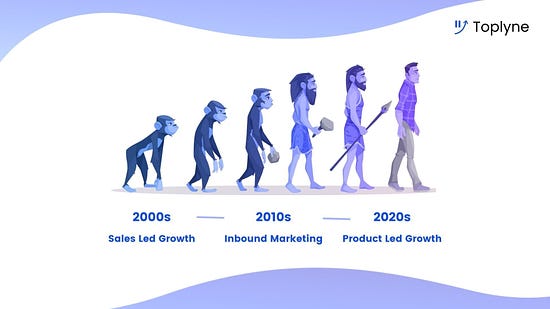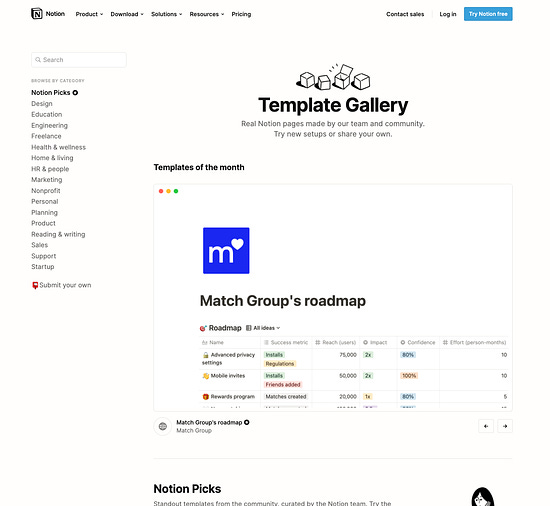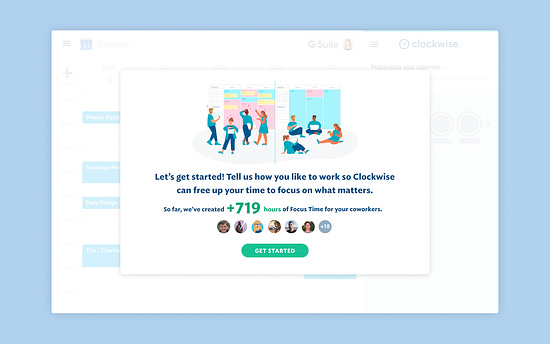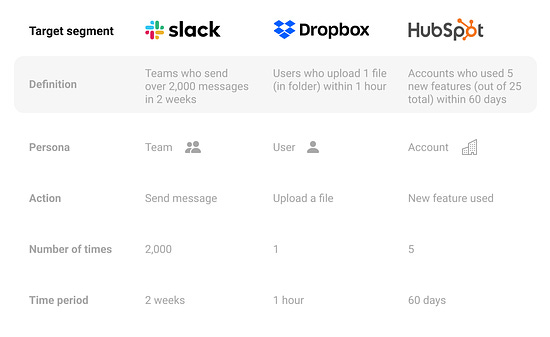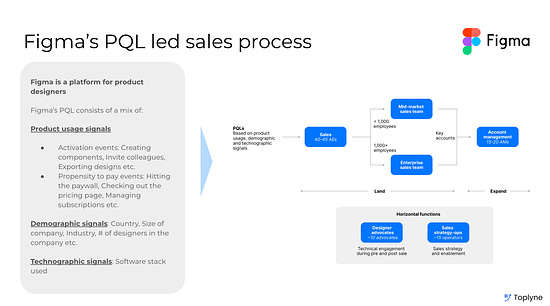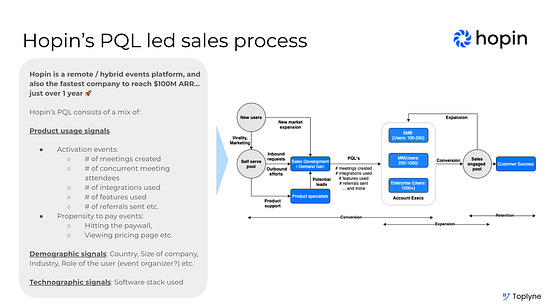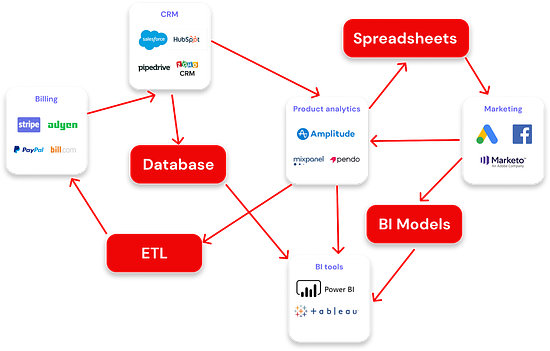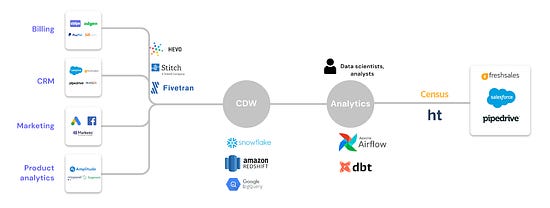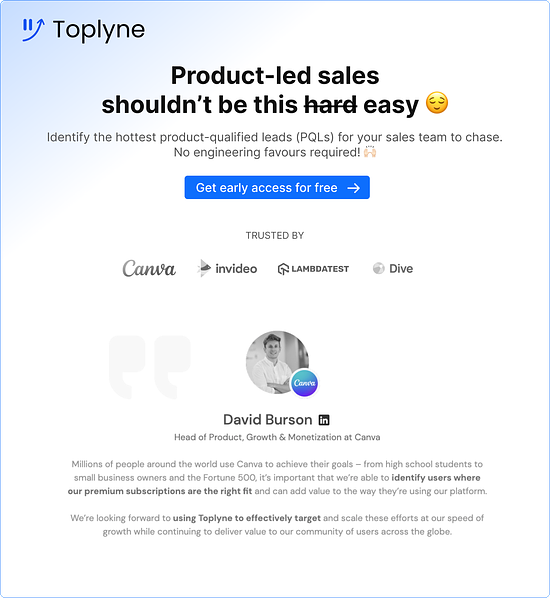Product led growth: What makes Canva, Figma & Shopify the best
Product led growth: What makes Canva, Figma & Shopify the bestFrom being great story-tellers to delivering value fast and leveraging product qualified leads (PQLs), the best PLG companies are a cut above the rest👋🏻 Hey, Ruchin here! Welcome to another edition of the Growth Stories series 🙌🏻 Every week we break down growth strategies employed by the hottest SaaS PLG Cos and share tactics that you can experiment with at work! If you’re a new subscriber or if you couldn’t find our emails this last month, fret not - We have you covered ❤️! Here are some of our recent editions to take you up to speed. Darwin's law of SaaS go-to-market evolutionAct 1: The 2000s and the reign of the salesperson!
In the early 2000s, the SaaS go-to-market motion was entirely sales-led. It made sense to carve out a budget for your sales teams to wine and dine CXOs of potential customers because that was the only way large enterprise accounts were going to find out about your hot new product. The protagonist of the story was sales. Supporting actors were unheard of. Act 2: The early 2010s and the evolution of inbound marketing
The 2010s saw the sales-led motions evolve to inbound marketing where focused, targeted campaigns replaced steak dinners and top-golf and widened the top of the funnel (ToFu), paving the way for Marketing Qualified Leads (MQLs) to be handed over to Sales. And as for good ol' Sales, the supporting act meant more potential buyers reaching out to them, and in turn, more conversions 🚀 Act 3: The 2020s - the Product strikes back
For those in the audience paying attention, this should come as no surprise. The continuing trend of a closing gap between the buyers and sellers of software was always going to result in both ultimately coming together. The era of the top-down determination of which software teams used left no room for experimentation among end-users and sometimes resulted in 7-figure software gathering dust on shelves. But why now?
In the wake of Covid-19, we witnessed two years' worth of digital transformation in just two months. Every company is now becoming a software company, and a million applications are just a few clicks away. In a world where anyone can take your software for a spin, end-user adoption and retention are functions of how much value your application can deliver over your competition.
Product led growth emerged as a Darwinian alternative mirroring survival in the wild. A low-risk environment where teams discovered and experimented with software was always likely to forge resilient strains of the product. Only the best emerge from the crucible because they provide the best experiences to the end-user. Coupled with Sales & Marketing becoming way more expensive than ever before, it only made sense for the product to become the protagonist, and for Sales and Marketing to step into supporting roles.
There are only two kinds of SaaS companies in the world today:
Product Led Growth (PLG) is the natural next step in an evolution that's been playing out for decades. And as for the other millions of software companies that are yet to be born into this world, the ink is dry on the product being the driver of growth. What separates the best from the rest
Imagine running an algorithm to adapt your product to optimize for end-user delight, and imagine all your competitors doing the same thing. In this highly competitive space where the margins are so thin, the clear winners are those who go the extra mile. But what does that extra mile look like? Over the last year, we've spoken with 100s of PLG companies - all the way from seed stage to public market giants. And after all those conversations, our pattern matching spidey senses were tingling ✨
P.S. You can take a consultant out of McKinsey but not McKinsey out of a consultant amirite? #1: The best PLG companies tell the best stories 💭Imagine yourself as a young PLG company. You're up against the giants. The behemoths. You're up against Amazon! You need to convince merchants that your buggy little tool that helps them create e-commerce stores online is the solution to all their problems. It's going to change their lives.
The way the best PLG companies approach this problem is step 1 to why they succeed. They appeal to their customer's emotion. Their core drivers. A merchant on Amazon often feels constrained to the fate the overlords have planned for him or her.
Shopify - “We help people achieve independence by making it easier to start, run, and grow a business.” Shopify’s mission appeals to the indie spirit and freedom from being under someone else’s thumb. (looking at you, Spotify 😒) Stripe - "Our mission is to increase the GDP of the internet." In typical Patrick Collison fashion, Stripe appealed to the DNA of every young Silicon Valley founder building an online business. Clockwise - “Help the world make time for what matters.” It's easy to take Clockwise's impact on your calendar for granted. But their mission is a stark reminder of the impact this glorious little Chrome extension can have on our lives. Sourcegraph - "...to make it so everyone can code, we will create tools, networks, and incentives for coding at ever-larger scale." While 'code-search' is a succinct way to describe Sourcegraph to a developer, their mission applies to all. Postman - Postman's founders have said often that their long-term vision is to add "net new developers" to the world. Airtable - "Our mission is to democratize software creation by enabling anyone to build the tools that meet their needs." Airtable's vision is much more grandiose than to just be the spiritual successor to MS Excel. Canva - "...with a mission to empower everyone in the world to design anything and publish anywhere." Canva's narrative is the democratization of design. #2:️ The best PLG companies deliver value... blazingly fast ⚡
In the attention economy, every product is competing with some other product for end-user attention and those who can deliver value without beating around the bush stand to pull ahead of the pack. Here's an example: How much time do you think it takes to build a Christmas card on Canva? Well, we timed it. Even without an account, it takes all of 52 seconds 🤯 to fire up the website, find a template, customize it, and export it to your desktop.
However, not all tools can deliver value in 52 seconds. And that's totally okay! Some inherently serve more complex use cases than Canva, but even then, product led growth companies guarantee that the outcome is made visible to the end-user within minutes of discovering the product. This is typically done through template galleries. Be it Algolia, Airtable, Retool, or Notion, at no point does the end-user have to engage in mental gymnastics to imagine the value proposition. Case in point: Here's Notion's standard template gallery. The decision to create a user-generated (UGC) templated gallery was notably the inflection in Notion's journey from growing fast to growing at a breakneck clip!
Sometimes, the amount of time it takes for a product to deliver value is high by design. Consider Clockwise, where the value proposition is time itself. How do you deliver value fast? Clockwise does this in two ways:
#3:️ The best PLG companies sell scientifically 🧬
Having an abundance of product-usage data enables PLG companies to qualify leads based on product-usage signals. PLG companies move SQLs and MQLs into the background and instead focus on product qualified leads (PQLs):
PQL definitions can vary based on the nature of the product, but at its core, it remains a function of a combination of persona, actions fired, # of times, and time period. PQLs are typically derived from a mix of product signals, demographic signals (country, size of company, industry, etc.), and technographic signals (software stack used). For Figma, the product-usage signals considered for PQLs are a mix of activation events like creating components, inviting colleagues, exporting designs, etc., or propensity-to-pay-events like hitting the paywall, checking the pricing page.
Whereas, for Hopin the product-usage signals are instead # meetings created, # of concurrent meeting attendees, # of integrations used, # of features used, # of referrals sent, etc.
Okay so PQLs are the answer to all our problems, right? Wellllll... we've not been entirely honest with you. While PQLs are easy to conceptualize, they're notoriously hard to implement 😬
In the fast-paced, data-backed world of PLG, implementation of PQLs is where most companies falter. At over 95% of the companies we spoke with, the "PQL implementation project" was lost to a spider web 🕸 that can only be described as DIY hell! 👹 A chaotic criss cross of spreadsheets, CRMs, product usage information held together by a disparate set of Excel or Google Sheet files... yikes!
These companies have gone the extra mile and have created an intricate infrastructure of engineering and data science, to implement and operationalize PQLs!
In an ideal world, every Product-Led Growth company has the internal capabilities, the bandwidth, and the resources to set up a flow where a data science team defines PQLs in tandem with a data engineering + platform engineering team that funnels data from Billing, CRMs, Marketing, and Product Analytics databases while simultaneously streamlining the whole process to funnel the leads back into the CRMs.
One tool to rule them allWith tech transformation stepping into high gear in the wake of the pandemic and the clairvoyance that product-led growth is the way forward, most SaaS companies will be PLG companies and what's more... most of them are yet to be born into this world. For the up-and-coming PLG company, time and resources spent building infrastructure as complicated as Slack's or Figma's is time and resources better spent on the core product. We built Toplyne to take this daunting task off the hands of companies who face the dilemma of massive top-of-funnel growth coupled with the inability to set up this massive infrastructure. Infrastructure that is indispensable to converting users from free to paid plans. Setting up something similar to the scary stack shown here is a nightmare for a young PLG company, but all of this heavy lifting just sounds like Toplyne... with extra steps. 😉 Some housekeeping… Is your mailbox trying to keep our content away from you! What can you do about it? Mark this email as ‘not spam’ or move it from your promotions to the primary folder It’s very easy! Thanks again, and please tell a few friends if you feel like it. If you liked this post from Top of the Lyne, why not share it? |
Older messages
Airtable's valuation crosses $10B, Superhuman open-sources success, famous last words of pre-IPO PLG companies, Re…
Thursday, December 16, 2021
👋 Hey, Ruchin here! Welcome to this week's edition of the ✨Top of the Lyne✨ newsletter. Each week we publish the hottest news from the beautiful world of product-led growth! (PLG) The outcome we
Replit: Printing “hello world” shouldn't be this easy!
Tuesday, December 14, 2021
The growth and product strategies fueling Replit's browser-based coding revolution!
Asynchronous funding rounds - Danke, Loom! The Return of the Power Law, Is PLG the end of sales, and more...
Thursday, December 9, 2021
The Time Traveller's Debugger, HashiCorp's IPO, Gadget and Circle's fundraises, and finally Loom, Zoom, Room, and Boom!
Growing 5x in one year with $0 spent: A Clockwise masterclass
Tuesday, December 7, 2021
Clockwise's turbocharged product-led growth engine that drove an organic bottom-up growth of over 5% week over week
How to GROW without really trying... for Dummies! All hail the power law, exceptions becoming the norm, and more...
Thursday, December 2, 2021
👋 Hey, Ruchin here! Welcome to this week's edition of the ✨Top of the Lyne✨ newsletter. Each week we publish the hottest news from the beautiful world of product-led growth! (PLG) The outcome we
You Might Also Like
🚀 Ready to scale? Apply now for the TinySeed SaaS Accelerator
Friday, February 14, 2025
What could $120K+ in funding do for your business?
📂 How to find a technical cofounder
Friday, February 14, 2025
If you're a marketer looking to become a founder, this newsletter is for you. Starting a startup alone is hard. Very hard. Even as someone who learned to code, I still believe that the
AI Impact Curves
Friday, February 14, 2025
Tomasz Tunguz Venture Capitalist If you were forwarded this newsletter, and you'd like to receive it in the future, subscribe here. AI Impact Curves What is the impact of AI across different
15 Silicon Valley Startups Raised $302 Million - Week of February 10, 2025
Friday, February 14, 2025
💕 AI's Power Couple 💰 How Stablecoins Could Drive the Dollar 🚚 USPS Halts China Inbound Packages for 12 Hours 💲 No One Knows How to Price AI Tools 💰 Blackrock & G42 on Financing AI
The Rewrite and Hybrid Favoritism 🤫
Friday, February 14, 2025
Dogs, Yay. Humans, Nay͏ ͏ ͏ ͏ ͏ ͏ ͏ ͏ ͏ ͏ ͏ ͏ ͏ ͏ ͏ ͏ ͏ ͏ ͏ ͏ ͏ ͏ ͏ ͏ ͏ ͏ ͏ ͏ ͏ ͏ ͏ ͏ ͏ ͏ ͏ ͏ ͏ ͏ ͏ ͏ ͏ ͏ ͏ ͏ ͏ ͏ ͏ ͏ ͏ ͏ ͏ ͏ ͏ ͏ ͏ ͏ ͏ ͏ ͏ ͏
🦄 AI product creation marketplace
Friday, February 14, 2025
Arcade is an AI-powered platform and marketplace that lets you design and create custom products, like jewelry.
Crazy week
Friday, February 14, 2025
Crazy week. ͏ ͏ ͏ ͏ ͏ ͏ ͏ ͏ ͏ ͏ ͏ ͏ ͏ ͏ ͏ ͏ ͏ ͏ ͏ ͏ ͏ ͏ ͏ ͏ ͏ ͏ ͏ ͏ ͏ ͏ ͏ ͏ ͏ ͏ ͏ ͏ ͏ ͏ ͏ ͏ ͏ ͏ ͏ ͏ ͏ ͏ ͏ ͏ ͏ ͏ ͏ ͏ ͏ ͏ ͏ ͏ ͏ ͏ ͏ ͏ ͏ ͏ ͏ ͏ ͏ ͏ ͏ ͏ ͏ ͏ ͏ ͏ ͏ ͏ ͏ ͏ ͏ ͏ ͏ ͏ ͏ ͏ ͏ ͏ ͏ ͏ ͏ ͏ ͏ ͏ ͏ ͏ ͏ ͏ ͏
join me: 6 trends shaping the AI landscape in 2025
Friday, February 14, 2025
this is tomorrow Hi there, Isabelle here, Senior Editor & Analyst at CB Insights. Tomorrow, I'll be breaking down the biggest shifts in AI – from the M&A surge to the deals fueling the
Six Startups to Watch
Friday, February 14, 2025
AI wrappers, DNA sequencing, fintech super-apps, and more. ͏ ͏ ͏ ͏ ͏ ͏ ͏ ͏ ͏ ͏ ͏ ͏ ͏ ͏ ͏ ͏ ͏ ͏ ͏ ͏ ͏ ͏ ͏ ͏ ͏ ͏ ͏ ͏ ͏ ͏ ͏ ͏ ͏ ͏ ͏ ͏ ͏ ͏ ͏ ͏ ͏ ͏ ͏ ͏ ͏ ͏ ͏ ͏ ͏ ͏ ͏ ͏ ͏ ͏ ͏ ͏ ͏ ͏ ͏ ͏ ͏ ͏ ͏ ͏ ͏ ͏ ͏ ͏ ͏ ͏ ͏
How Will AI-Native Games Work? Well, Now We Know.
Friday, February 14, 2025
A Deep Dive Into Simcluster ͏ ͏ ͏ ͏ ͏ ͏ ͏ ͏ ͏ ͏ ͏ ͏ ͏ ͏ ͏ ͏ ͏ ͏ ͏ ͏ ͏ ͏ ͏ ͏ ͏ ͏ ͏ ͏ ͏ ͏ ͏ ͏ ͏ ͏ ͏ ͏ ͏ ͏ ͏ ͏ ͏ ͏ ͏ ͏ ͏ ͏ ͏ ͏ ͏ ͏ ͏ ͏ ͏ ͏ ͏ ͏ ͏ ͏ ͏ ͏ ͏ ͏ ͏ ͏ ͏ ͏ ͏ ͏ ͏ ͏ ͏ ͏ ͏ ͏ ͏ ͏ ͏ ͏ ͏ ͏ ͏ ͏ ͏ ͏ ͏ ͏ ͏
